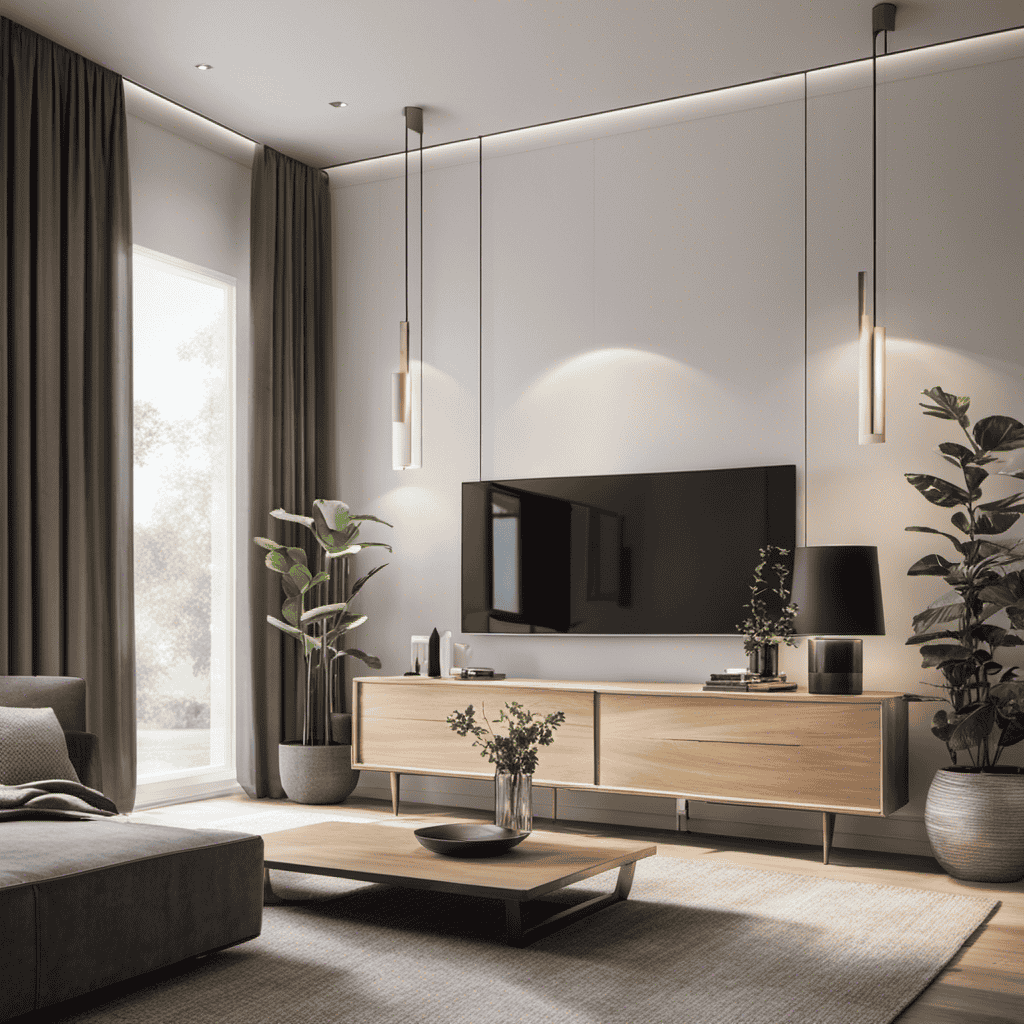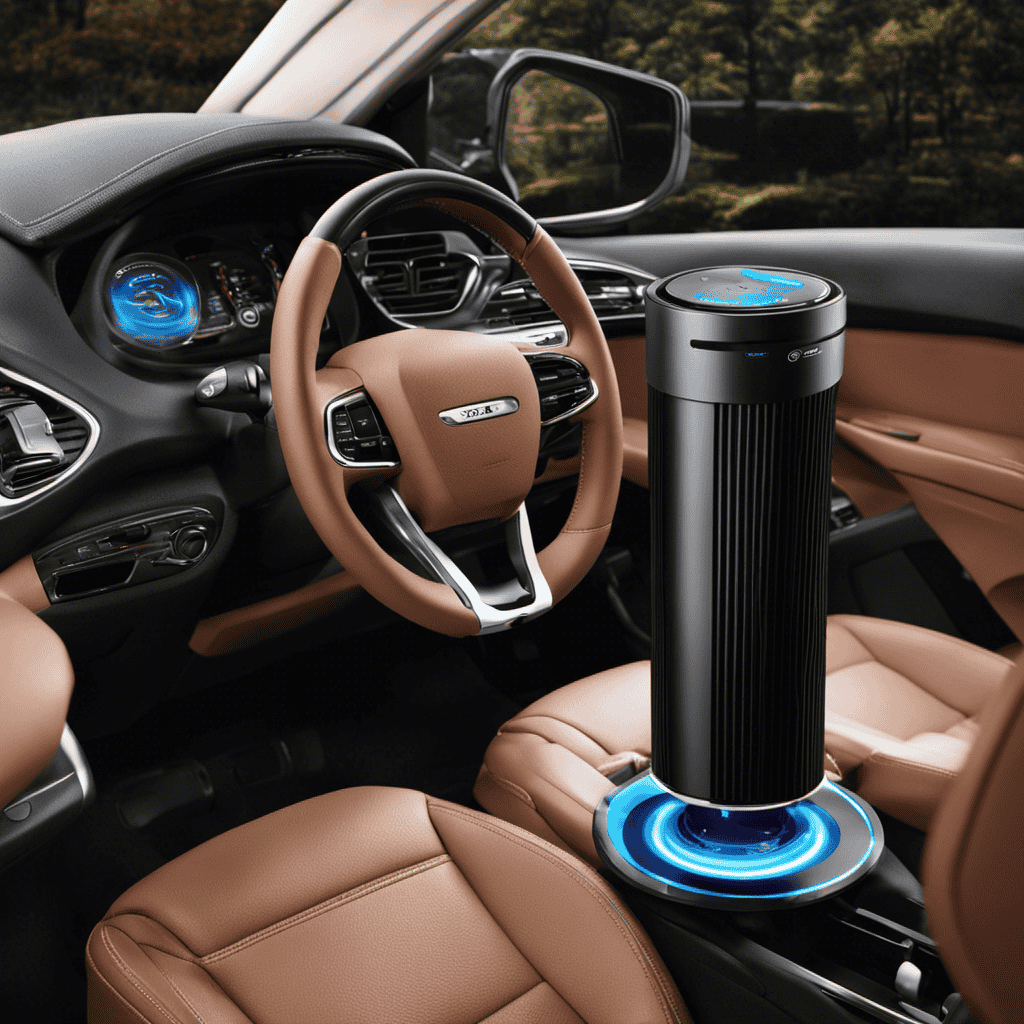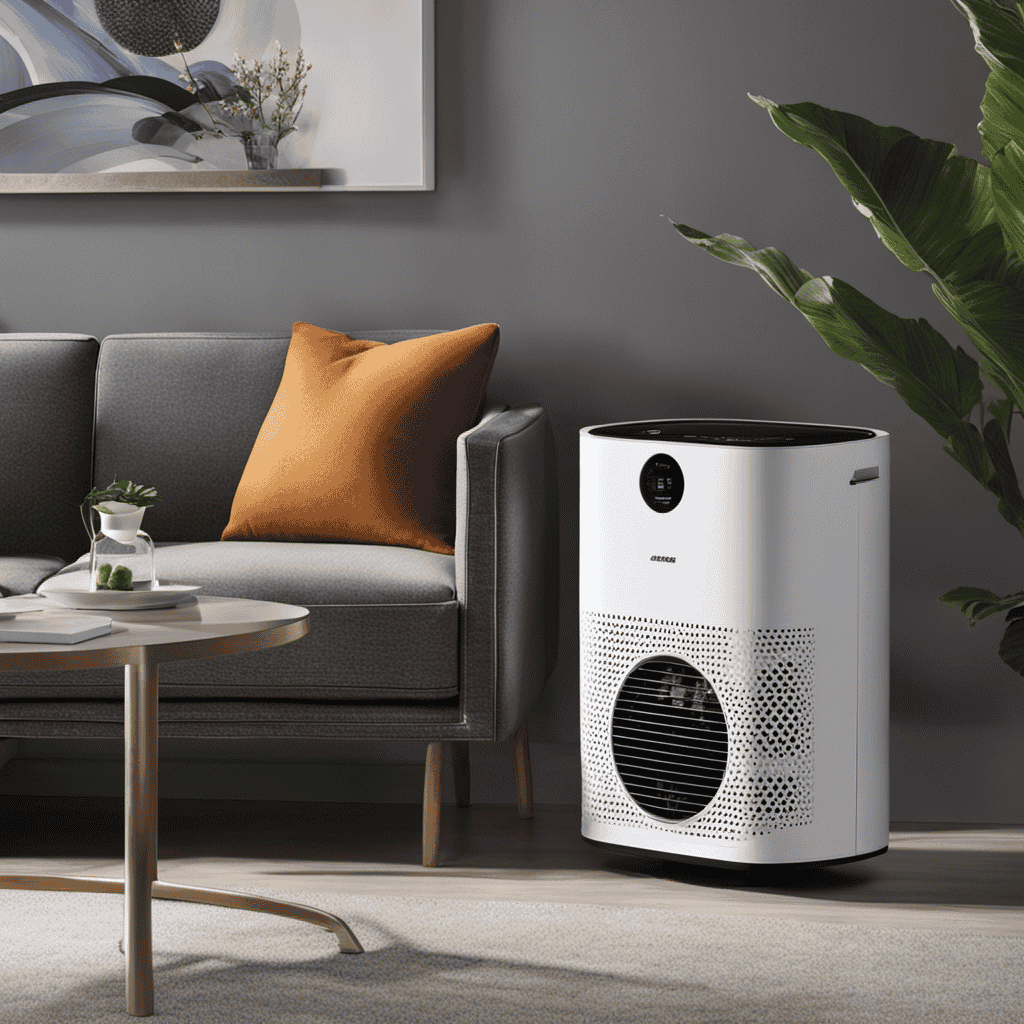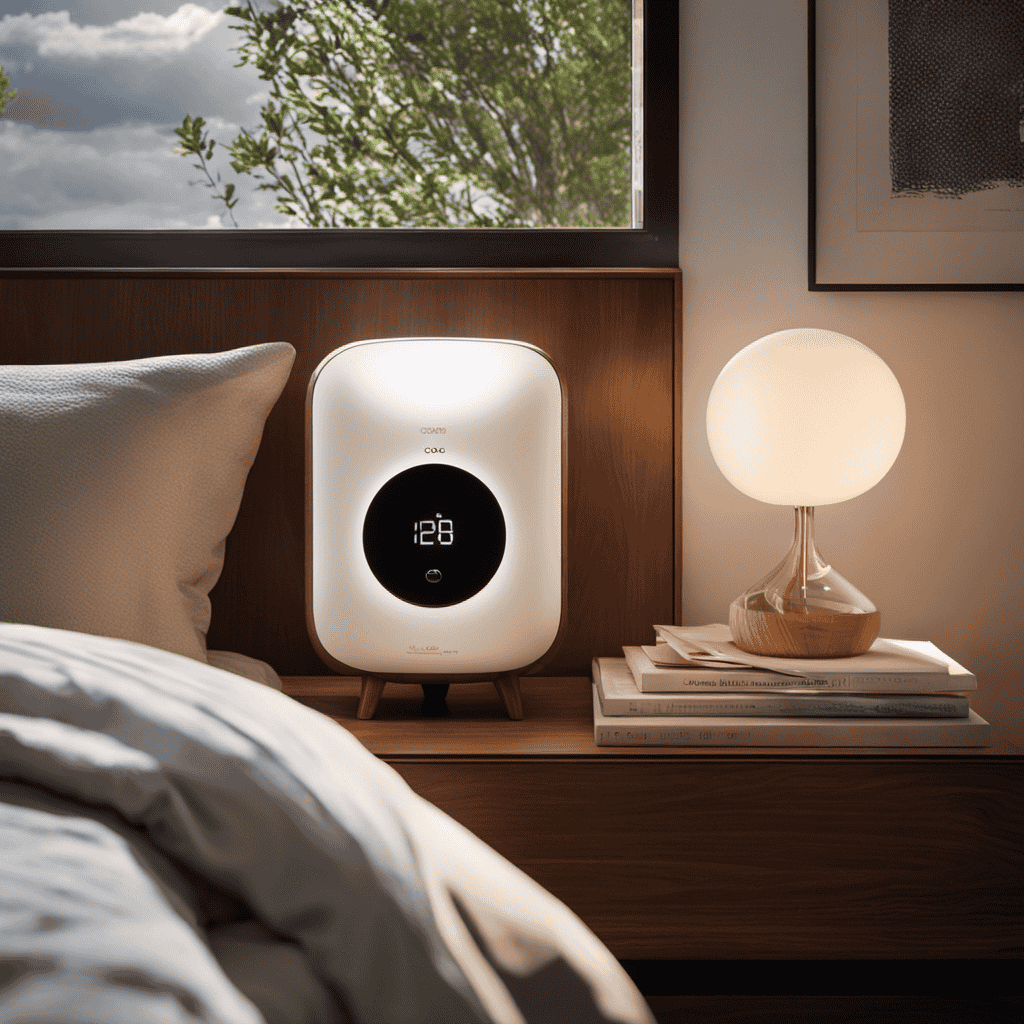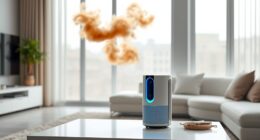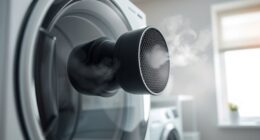As the owner of an air purifier, I understand the importance of keeping the filters clean to ensure healthy indoor air quality. Just like a car needs regular maintenance to operate well, air purifier filters need regular cleaning to work effectively.
In this article, I will guide you through the step-by-step process of cleaning your air purifier filters, ensuring that you have the necessary knowledge and tools to keep your air purifier running at its best.
So let’s roll up our sleeves and get started!
Key Takeaways
- Regular maintenance of air purifier filters is crucial for optimal air quality.
- Clean filters improve indoor air quality by trapping pollutants and allergens.
- Cleaning filters improves energy efficiency by reducing the workload on the purifier.
- Regular cleaning maintains optimal air quality, extends filter lifespan, and saves money on replacements.
Understanding the Importance of Cleaning Air Purifier Filters
Understanding the importance of cleaning air purifier filters is crucial for maintaining optimal air quality. Regular maintenance of these filters is essential to ensure that they continue to function effectively and provide the many benefits of clean air purifier filters.
One of the main benefits of clean air purifier filters is improved indoor air quality. Air purifiers are designed to remove pollutants and allergens from the air, such as dust, pet dander, pollen, and mold spores. However, if the filters are dirty and clogged, they cannot effectively trap these particles, leading to poor air quality. Regularly cleaning the filters helps to remove these contaminants and ensures that the air purifier can continue to do its job effectively.
Another benefit of cleaning air purifier filters is improved energy efficiency. When the filters are clean, the air purifier doesn’t have to work as hard to push air through the system. This means that it consumes less energy, reducing electricity costs and environmental impact.
In addition, regular maintenance can prolong the lifespan of the air purifier. When filters are dirty, the air purifier has to work harder, leading to increased wear and tear on the motor. By cleaning the filters regularly, you can help to extend the lifespan of the unit and avoid costly repairs or replacements.
Identifying the Type of Air Purifier Filter You Have
To figure out the type of filter you have, start by checking the user manual. It’s always a good idea to familiarize yourself with the specific filter type in your air purifier, as different filters require different cleaning methods.
There are several common types of air purifier filters, including HEPA filters, activated carbon filters, and pre-filters.
HEPA filters are highly efficient in capturing small particles like dust, pollen, and pet dander. These filters can become clogged over time and may need to be replaced rather than cleaned.
Activated carbon filters are effective at removing odors and harmful gases from the air. These filters need to be replaced regularly to maintain their effectiveness.
Pre-filters are the first line of defense in an air purifier and capture larger particles like hair and lint. They can usually be cleaned by vacuuming or rinsing with water.
Common problems with air purifier filters include clogging, reduced airflow, and foul odors. Regularly cleaning or replacing your air purifier filters is essential to maintain optimal performance and ensure clean air in your home.
Remember to follow the manufacturer’s instructions for cleaning and replacing filters, as improper maintenance can lead to decreased efficiency and potential damage to your air purifier.
Gathering the Necessary Cleaning Supplies
Make sure you have all the supplies you need for cleaning, such as a vacuum, water, and cleaning solution. Cleaning your air purifier filters is an important maintenance task that helps to ensure the optimal performance of your device. In order to effectively clean your filters, you will need a few essential cleaning supplies. Here is a list of the supplies you will need:
| Supplies | Description |
|---|---|
| Vacuum | A vacuum cleaner with a brush attachment will help you remove any loose dust and debris from your filters. |
| Water | You will need water to rinse off the filters and remove any stubborn dirt or grime. Make sure the water is at room temperature to avoid damaging the filters. |
| Cleaning Solution | An appropriate cleaning solution, such as a mild detergent or vinegar solution, will help to remove any trapped pollutants and odors from the filters. |
| Soft Cloth or Brush | A soft cloth or brush can be used to gently scrub the filters and remove any remaining dirt or residue. |
Step-by-Step Guide to Removing the Air Purifier Filter
First, you’ll want to locate the access panel on your device in order to remove the air purifier filter. This step is crucial for proper maintenance and cleaning.
Here’s a step-by-step guide to help you through the process:
- Step 1: Turn off and unplug your air purifier to ensure safety during the cleaning process.
- Step 2: Locate the access panel on your device. This can usually be found on the back or side of the unit.
- Step 3: Carefully remove the access panel by unscrewing or sliding it off, depending on the design of your purifier.
- Step 4: Once the access panel is removed, you will have access to the air purifier filter. Take note of how the filter is positioned, as you will need to put it back correctly later.
- Step 5: Gently remove the filter from its housing. If it’s reusable, give it a thorough cleaning using water and a mild detergent. If it’s a disposable filter, replace it with a new one according to the manufacturer’s instructions.
Proper storage techniques for air purifier filters involve keeping them in a dry and clean place, away from direct sunlight or extreme temperatures. This helps to maintain their efficiency and prolong their lifespan.
When troubleshooting common filter cleaning issues, make sure to check for any clogs or damage. If the filter is still dirty after cleaning, it may be time to replace it. Additionally, be cautious when handling air purifier filters to avoid tearing or damaging them.
Preparing the Cleaning Solution for the Filter
Once you’ve gathered the necessary ingredients, it’s time to mix the cleaning solution for the filter. Cleaning your air purifier filter is an important step to maintain its effectiveness and prolong its lifespan.
To prepare the cleaning solution, you will need a few common household items. First, grab a large bowl or basin and fill it with warm water. Next, add a few drops of mild dish soap or a designated air purifier filter cleaner. Be sure to read the manufacturer’s instructions to ensure the cleaning solution is compatible with your filter. Gently mix the solution until it is well blended.
When it comes to cleaning techniques, it’s crucial to handle the filter with care. Remove the filter from the air purifier and place it in the cleaning solution. Allow it to soak for about 10-15 minutes, allowing the solution to penetrate and loosen any dirt or debris trapped in the filter.
After soaking, use a soft brush or cloth to gently scrub the filter, paying close attention to any stubborn areas. Rinse the filter thoroughly with clean water to remove any soap residue.
Proper Techniques for Cleaning Different Types of Filters
To effectively maintain and prolong the lifespan of your filters, it’s important to understand the proper techniques for cleaning different types. Cleaning your filters not only improves the air quality in your home but also ensures the optimal functioning of your air purifier. Here are some key techniques for cleaning different types of filters:
-
Foam Filters: Remove the foam filter from the air purifier and gently rinse it with warm water. Avoid using harsh chemicals or scrubbing vigorously as it can damage the filter. Allow the filter to air dry completely before reinserting it.
-
Activated Carbon Filters: Activated carbon filters cannot be cleaned and should be replaced when they become saturated with odors. Follow the manufacturer’s instructions for the recommended replacement schedule.
-
HEPA Filters: HEPA filters can be cleaned by vacuuming them with a soft brush attachment or by rinsing them gently with water. Allow the filter to dry completely before reinstalling it. Note that not all HEPA filters are washable, so refer to the manufacturer’s instructions.
-
Electrostatic Filters: Electrostatic filters can be cleaned by gently washing them with warm water and mild soap. Rinse thoroughly and allow the filter to air dry completely before reusing it.
-
UV Filters: UV filters do not require cleaning as the UV light kills bacteria and viruses. However, it’s important to replace the UV bulb according to the manufacturer’s guidelines.
Tips for Thoroughly Cleaning the Filter
One important tip for thoroughly cleaning the filter is to make sure you remove any loose debris or particles before washing it. This step is crucial because if you don’t remove the loose debris, it can clog the filter during the cleaning process. To remove the debris, use a soft brush or vacuum cleaner to gently sweep or suction it away. Be careful not to damage the filter while doing this.
When it comes to deep cleaning your air purifier filter, there are a few tips to keep in mind. Firstly, always refer to the manufacturer’s instructions for the specific cleaning method recommended for your filter. Different filters may require different cleaning techniques. Secondly, avoid using harsh chemicals or detergents to clean the filter. These can damage the filter material and reduce its effectiveness. Instead, opt for mild soap and water or a specialized filter cleaning solution.
It’s also important to avoid common mistakes when cleaning the filter. One common mistake is not allowing the filter to dry completely before reinserting it into the air purifier. Damp filters can become a breeding ground for mold and bacteria, compromising the air quality in your home. Another mistake is not cleaning the filter regularly. Depending on the usage and the environment, filters should be cleaned at least once every three to six months.
Drying and Reassembling the Filter
When it comes to maintaining the efficiency of an air purifier, two key steps are air drying the filter and proper reassembly techniques.
After cleaning the filter, it is crucial to allow it to thoroughly dry before putting it back into the purifier. This helps prevent moisture buildup and potential mold growth.
Additionally, taking the time to properly reassemble the filter ensures a tight seal and optimal performance of the air purifier.
Air Drying the Filter
First, make sure you’ve thoroughly rinsed the filter under cold water. Once the filter is clean, it’s important to properly dry it before reassembling your air purifier.
Air drying the filter is the best method to ensure it doesn’t develop any mold or mildew. Here are some air drying techniques and the benefits of air drying:
- Place the filter in a well-ventilated area
- Allow the filter to dry naturally for at least 24 hours
- Avoid using heat sources or direct sunlight, as this can damage the filter
- Check the filter periodically to ensure it is completely dry before reassembling
- Air drying helps to remove any remaining moisture, preventing bacterial growth and maintaining filter efficiency
Proper Reassembly Techniques
To properly reassemble your air purifier, ensure that the filter is completely dry before moving on.
Reassembling an air purifier may seem like a simple task, but there are a few tips that can help ensure a successful reassembly process.
First, make sure to carefully follow the manufacturer’s instructions for reassembly, as each model may have specific requirements.
It’s also important to avoid common mistakes, such as forcing the parts together or overtightening screws, as this can damage the unit.
Take your time and double-check that all parts are aligned correctly before securing them in place.
How Often Should You Clean Your Air Purifier Filter
I’m often asked how often one should clean their air purifier filter, and it’s an important question to address.
The optimal cleaning frequency depends on factors such as the type of filter, the level of air pollution in your area, and the usage of your air purifier.
Signs of dirty filters can include decreased airflow, increased noise levels, and a decrease in the air quality of your space.
It’s crucial to stay vigilant and address these signs promptly to ensure that your air purifier is working effectively.
Optimal Cleaning Frequency
Cleaning air purifier filters regularly is essential for maintaining optimal air quality in your home. Regular maintenance not only ensures that your air purifier is working efficiently, but it also prolongs the lifespan of the filters. Here are 5 important reasons why regular cleaning is necessary:
- Improves air circulation and flow, allowing the purifier to effectively remove pollutants.
- Reduces the risk of allergens and irritants being released back into the air.
- Prevents clogging and build-up of dirt and debris, which can hinder the purifier’s performance.
- Extends the lifespan of the filters, saving you money on replacements.
- Ensures that your air purifier continues to provide clean and healthy air for you and your family.
Signs of Dirty Filters?
Now that we know how often to clean air purifier filters, it’s important to understand the signs that indicate when they are dirty.
Regular cleaning is crucial for maintaining the efficiency and effectiveness of our air purifiers. One of the first signs of dirty filters is a noticeable decrease in air quality. If you start noticing more dust particles, allergens, or unpleasant odors in the air, it’s a clear indication that the filters need cleaning.
Another sign is reduced airflow. When the filters are clogged with dirt and debris, it becomes harder for the air to pass through, resulting in weaker airflow.
Signs That Your Air Purifier Filter Needs Cleaning
To determine if your air purifier filter needs cleaning, take note of any unusual smells or a decrease in air flow. These are warning signs that your filter may be clogged with dust, allergens, and other particles. Regular maintenance is crucial to ensure that your air purifier functions effectively and provides clean air for your home.
Here are a few indicators that it’s time to clean your air purifier filter:
- Visible dirt and dust buildup on the filter surface.
- A decrease in the efficiency of your air purifier.
- Increased allergy symptoms or respiratory issues.
- Unpleasant odors lingering in the air.
- The filter indicator light on your air purifier is illuminated.
Cleaning your air purifier filter is essential to maintain its efficiency and performance. Regular cleaning not only improves air quality but also extends the lifespan of your filter.
In the next section, I will provide you with detailed maintenance tips that will help you keep your air purifier filter running smoothly and effectively.
Maintaining the Efficiency of Your Air Purifier Filter
When it comes to maintaining the efficiency of your air purifier filter, two key factors to consider are the frequency of cleaning and the proper cleaning techniques.
Regular cleaning is essential to ensure that your filter is working effectively in removing pollutants from the air. Knowing how often to clean your filter and the correct methods to use will help prolong its lifespan and maintain its efficiency in purifying the air in your home.
Frequency of Cleaning
Cleaning your air purifier filters regularly is crucial for maintaining optimal air quality in your home. Neglecting to clean your filters can result in reduced efficiency and a buildup of dirt, dust, and allergens in the air. Regular cleaning not only ensures that your air purifier is working effectively, but it also provides several benefits for you and your family:
-
Improved Indoor Air Quality: Clean filters remove airborne particles, such as dust, pet dander, and pollen, helping to create a healthier living environment.
-
Reduction of Allergies and Asthma Symptoms: By capturing and trapping allergens, clean filters can alleviate allergy and asthma symptoms, making it easier to breathe.
-
Extended Lifespan of Your Air Purifier: Regularly cleaning your filters can prevent clogs and damage to the internal components of your air purifier, thereby extending its lifespan.
-
Energy Efficiency: Clean filters allow your air purifier to operate more efficiently, reducing energy consumption and saving you money on your utility bills.
-
Peace of Mind: Knowing that your air purifier is equipped with clean filters gives you peace of mind, knowing that you and your family are breathing clean, fresh air.
Regular cleaning of your air purifier filters is an essential task that should not be overlooked. By doing so, you can enjoy the many benefits of clean air purifier filters, including improved air quality and a healthier living environment.
Proper Cleaning Techniques
Make sure you’re using the right cleaning techniques to maintain the effectiveness of your air purifier. Proper cleaning techniques are crucial for keeping your air purifier running smoothly and ensuring that it continues to remove pollutants from the air effectively.
Firstly, it is important to establish a regular cleaning schedule for your air purifier, as this will help prevent the build-up of dust and other contaminants on the filters. Common mistakes to avoid include using harsh cleaning agents, which can damage the filters, and neglecting to clean the pre-filters regularly.
To clean the filters, gently vacuum or rinse them under running water, taking care not to damage the delicate filter material. Allow the filters to dry completely before reassembling the air purifier and restarting it.
Frequently Asked Questions
Can I Clean My Air Purifier Filter With Just Water?
Yes, you can clean your air purifier filter with just water. It is one of the best practices for maintaining air purifier filters.
Water is a gentle and effective way to remove dirt, dust, and other particles from the filter. However, it’s important to follow the manufacturer’s instructions to ensure proper cleaning. Some filters may require additional cleaning agents or a specific cleaning process.
Regularly cleaning your air purifier filter will help to keep it functioning optimally and ensure clean and fresh air in your space.
Can I Use Any Type of Cleaning Solution to Clean My Air Purifier Filter?
Can I use any type of cleaning solution to clean my air purifier filter? Well, let’s explore the options, shall we?
While bleach might seem like a powerful cleaning agent, it’s not advisable to use it on your air purifier filter. The strong chemicals can damage the filter’s delicate components.
As for soap, it’s generally safe to use a mild, non-abrasive soap to clean the filter. Just make sure to rinse it thoroughly afterwards to remove any residue.
Can I Vacuum My Air Purifier Filter Instead of Washing It?
Vacuuming the air purifier filter is an alternative cleaning method that can be effective in removing dust and debris. However, it may not be as thorough as washing the filter.
While vacuuming can remove larger particles, it may not be able to eliminate smaller contaminants and allergens. Therefore, it is recommended to combine vacuuming with regular washing to ensure the filter is properly cleaned and maintains its effectiveness in purifying the air.
How Long Does It Take for an Air Purifier Filter to Dry?
Well, let me tell you, air purifier filters can take an eternity to dry!
But fear not, my friends, for I have some tricks up my sleeve to speed up the process.
First, make sure to remove as much moisture as possible by gently squeezing the filter.
Then, find a warm and dry place to let it air out.
If you’re feeling adventurous, you can even try using a hairdryer on a low, cool setting.
But whatever you do, please don’t put it in the dryer! Trust me, that won’t end well.
Can I Use My Air Purifier Without a Filter?
Using an air purifier without a filter is not recommended. Filters are an essential part of an air purifier’s functionality as they trap and remove pollutants from the air. Regular air purifier maintenance, including cleaning or replacing the filters, ensures that the purifier continues to effectively clean the air.
Filters provide numerous benefits, such as reducing allergens, dust, and odors in the air. Therefore, it’s important to always use a filter in your air purifier for optimal performance.
Can the Same Method for Cleaning Shark Air Purifier Filters be Applied to Other Air Purifiers?
When it comes to cleaning shark air purifier filters, the same method may not apply to other air purifiers. Different purifiers have varying designs and filter materials, requiring specific cleaning techniques. It’s essential to follow the manufacturer’s guidelines for each purifier to ensure proper maintenance and optimal performance.
Conclusion
In conclusion, cleaning your air purifier filter is essential for maintaining its efficiency and ensuring that it continues to provide clean and fresh air.
By following the step-by-step guide and using the right cleaning supplies, you can easily remove and clean your filter.
Remember to clean your filter regularly, as indicated by the manufacturer’s instructions, and pay attention to signs that it needs cleaning, such as reduced airflow or strange odors.
As the saying goes, ‘A clean air purifier filter is a breath of fresh air.’



